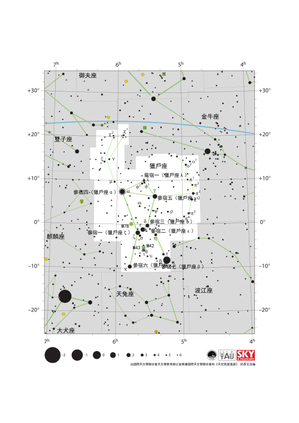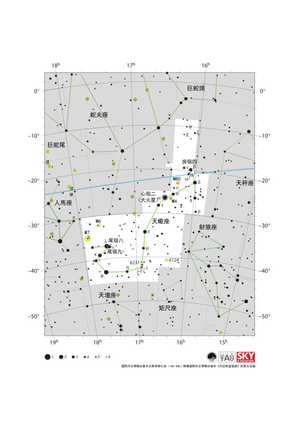Glossary term: 視星等
Description: 視星等是觀測者看到的天體亮度的量度。由於歷史原因,星等表將較大的數字分配給較暗的天體。星等是一個對數刻度,5 個星等的差異相當於測量亮度的 100 倍。由於亮度可以用不同的波長和不同的技術測量,因此有許多震級標度。常用的 "視星等 "刻度是這樣設定的:明亮的織女星的視星等為零。在這個星等表上,夜空中最亮的恆星天狼星的星等為-1.46,太陽和滿月的星等分別為-26.7 和-12.7。負數表示這些天體看起來比織女星更亮。在非常暗的條件下,視力極好的人可以看到約 6 等的恆星。哈勃超深視場的視星等接近 31 等。這比 6 等暗大約 100 到 5 的冪,或者說比 6 等暗 10,000,000,000 倍。
視星等是用來衡量天體在觀測者眼中亮度的一種度量。由於歷史原因,星等標尺將較大的數字分配給較暗的天體。視星等是一個對數刻度,星等相差5個單位時,亮度相差100倍。因為亮度可以在不同波長和通過不同技術進行測量,所以有多種星等標尺。常見的“視星等”尺度設定明亮的織女星視星等為0。在該標尺上,夜空中最亮的恆星天狼星的視星等為-1.46,太陽和滿月的視星等分別為-26.7和-12.7。負數表示這些天體比織女星更亮。在非常黑暗的條件下,視力極佳的人可以看到視星等約為6的恆星。而哈勃超深空的視星等接近31,這比視星等為6的恆星暗約100的五次方,即100億倍。
Related Terms:
See this term in other languages
Term and definition status: The original definition of this term in English have been approved by a research astronomer and a teacher The translation of this term and its definition is still awaiting approval
This is an automated transliteration of the simplified Chinese translation of this term
The OAE Multilingual Glossary is a project of the IAU Office of Astronomy for Education (OAE) in collaboration with the IAU Office of Astronomy Outreach (OAO). The terms and definitions were chosen, written and reviewed by a collective effort from the OAE, the OAE Centers and Nodes, the OAE National Astronomy Education Coordinators (NAECs) and other volunteers. You can find a full list of credits here. All glossary terms and their definitions are released under a Creative Commons CC BY-4.0 license and should be credited to "IAU OAE".
If you notice a factual or translation error in this glossary term or definition then please get in touch.
Related Diagrams
Andromeda Constellation Map
Credit: Adapted by the IAU Office of Astronomy for Education from the original by IAU/Sky & Telescope
License: CC-BY-4.0 Creative Commons 姓名標示 4.0 國際 (CC BY 4.0) icons
Crux Constellation Map
Credit: Adapted by the IAU Office of Astronomy for Education from the original by IAU/Sky & Telescope.
License: CC-BY-4.0 Creative Commons 姓名標示 4.0 國際 (CC BY 4.0) icons
獵戶座星圖
Credit: 由國際天文學聯合會天文教育辦公室根據國際天文學聯合會/《天空與望遠鏡》的原文改編
License: CC-BY-4.0 Creative Commons 姓名標示 4.0 國際 (CC BY 4.0) icons
天秤座星圖
Credit: 國際天文學聯合會天文教育辦公室(IAU OAE)根據國際天文學聯合會和《天空與望遠鏡》的原文改編
License: CC-BY-4.0 Creative Commons 姓名標示 4.0 國際 (CC BY 4.0) icons
天蠍座星圖
Credit: 國際天文學聯合會天文教育辦公室(IAU OAE)根據國際天文學聯合會和《天空與望遠鏡》的原文改編
License: CC-BY-4.0 Creative Commons 姓名標示 4.0 國際 (CC BY 4.0) icons













